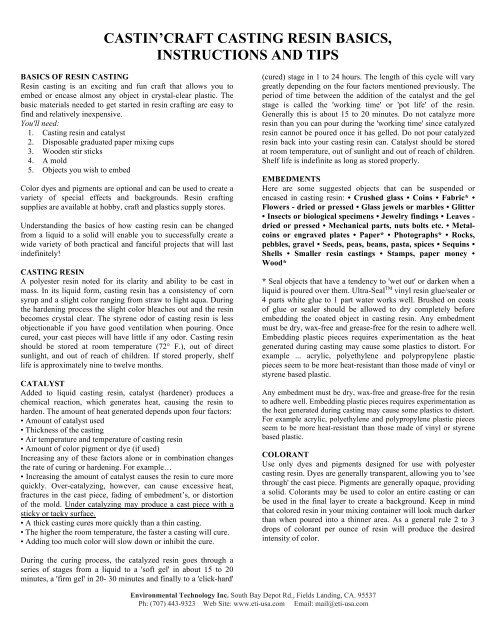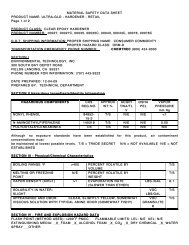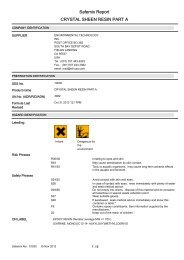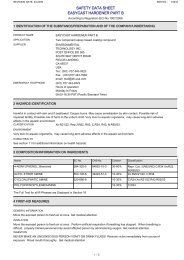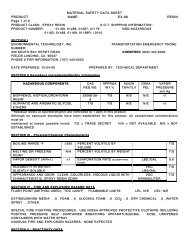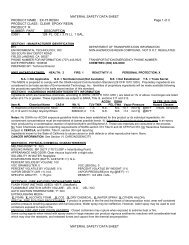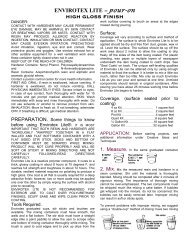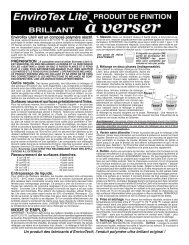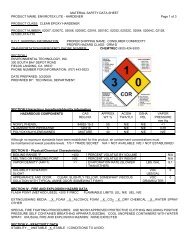Casting Resin Instructions - Environmental Technology Inc
Casting Resin Instructions - Environmental Technology Inc
Casting Resin Instructions - Environmental Technology Inc
Create successful ePaper yourself
Turn your PDF publications into a flip-book with our unique Google optimized e-Paper software.
CASTIN’CRAFT CASTING RESIN BASICS,INSTRUCTIONS AND TIPSBASICS OF RESIN CASTING<strong>Resin</strong> casting is an exciting and fun craft that allows you toembed or encase almost any object in crystal-clear plastic. Thebasic materials needed to get started in resin crafting are easy tofind and relatively inexpensive.You'll need:1. <strong>Casting</strong> resin and catalyst2. Disposable graduated paper mixing cups3. Wooden stir sticks4. A mold5. Objects you wish to embedColor dyes and pigments are optional and can be used to create avariety of special effects and backgrounds. <strong>Resin</strong> craftingsupplies are available at hobby, craft and plastics supply stores.Understanding the basics of how casting resin can be changedfrom a liquid to a solid will enable you to successfully create awide variety of both practical and fanciful projects that will lastindefinitely!CASTING RESINA polyester resin noted for its clarity and ability to be cast inmass. In its liquid form, casting resin has a consistency of cornsyrup and a slight color ranging from straw to light aqua. Duringthe hardening process the slight color bleaches out and the resinbecomes crystal clear. The styrene odor of casting resin is lessobjectionable if you have good ventilation when pouring. Oncecured, your cast pieces will have little if any odor. <strong>Casting</strong> resinshould be stored at room temperature (72° F.), out of directsunlight, and out of reach of children. If stored properly, shelflife is approximately nine to twelve months.CATALYSTAdded to liquid casting resin, catalyst (hardener) produces achemical reaction, which generates heat, causing the resin toharden. The amount of heat generated depends upon four factors:• Amount of catalyst used• Thickness of the casting• Air temperature and temperature of casting resin• Amount of color pigment or dye (if used)<strong>Inc</strong>reasing any of these factors alone or in combination changesthe rate of curing or hardening. For example…• <strong>Inc</strong>reasing the amount of catalyst causes the resin to cure morequickly. Over-catalyzing, however, can cause excessive heat,fractures in the cast piece, fading of embedment’s, or distortionof the mold. Under catalyzing may produce a cast piece with asticky or tacky surface.• A thick casting cures more quickly than a thin casting.• The higher the room temperature, the faster a casting will cure.• Adding too much color will slow down or inhibit the cure.(cured) stage in 1 to 24 hours. The length of this cycle will varygreatly depending on the four factors mentioned previously. Theperiod of time between the addition of the catalyst and the gelstage is called the 'working time' or 'pot life' of the resin.Generally this is about 15 to 20 minutes. Do not catalyze moreresin than you can pour during the 'working time' since catalyzedresin cannot be poured once it has gelled. Do not pour catalyzedresin back into your casting resin can. Catalyst should be storedat room temperature, out of sunlight and out of reach of children.Shelf life is indefinite as long as stored properly.EMBEDMENTSHere are some suggested objects that can be suspended orencased in casting resin: • Crushed glass • Coins • Fabric* •Flowers - dried or pressed • Glass jewels or marbles • Glitter• Insects or biological specimens • Jewelry findings • Leaves -dried or pressed • Mechanical parts, nuts bolts etc. • Metalcoinsor engraved plates • Paper* • Photographs* • Rocks,pebbles, gravel • Seeds, peas, beans, pasta, spices • Sequins •Shells • Smaller resin castings • Stamps, paper money •Wood** Seal objects that have a tendency to 'wet out' or darken when aliquid is poured over them. Ultra-Seal TM vinyl resin glue/sealer or4 parts white glue to 1 part water works well. Brushed on coatsof glue or sealer should be allowed to dry completely beforeembedding the coated object in casting resin. Any embedmentmust be dry, wax-free and grease-free for the resin to adhere well.Embedding plastic pieces requires experimentation as the heatgenerated during casting may cause some plastics to distort. Forexample ... acrylic, polyethylene and polypropylene plasticpieces seem to be more heat-resistant than those made of vinyl orstyrene based plastic.Any embedment must be dry, wax-free and grease-free for the resinto adhere well. Embedding plastic pieces requires experimentation asthe heat generated during casting may cause some plastics to distort.For example acrylic, polyethylene and polypropylene plastic piecesseem to be more heat-resistant than those made of vinyl or styrenebased plastic.COLORANTUse only dyes and pigments designed for use with polyestercasting resin. Dyes are generally transparent, allowing you to 'seethrough' the cast piece. Pigments are generally opaque, providinga solid. Colorants may be used to color an entire casting or canbe used in the final layer to create a background. Keep in mindthat colored resin in your mixing container will look much darkerthan when poured into a thinner area. As a general rule 2 to 3drops of colorant per ounce of resin will produce the desiredintensity of color.During the curing process, the catalyzed resin goes through aseries of stages from a liquid to a 'soft gel' in about 15 to 20minutes, a 'firm gel' in 20- 30 minutes and finally to a 'click-hard'<strong>Environmental</strong> <strong>Technology</strong> <strong>Inc</strong>. South Bay Depot Rd., Fields Landing, CA. 95537Ph: (707) 443-9323 Web Site: www.eti-usa.com Email: mail@eti-usa.com
MOLDSA variety of mold materials can be used for resin casting…Oven-proof glass, such as Pyrex TMLatex, natural rubberFlexible vinyl plastisolMetal, aluminum, stainless steelSilicone, R.T.V. rubberCeramicPolypropylene and polyethylenePolyurethane elastomers(Note: Some mold types require the use of a mold releaseto keep the casting from sticking to the mold.)STEPS TO PERFECT RESIN CASTING WITH'POLY' MOLDS PREPARATION• Read all instructions before starting your project! These includemanufacturer's label cautions as well as project directions.• Choose a well-ventilated area away from any food preparation,where a room temperature of 65° to 75° F. can be maintained.• Cover a level working surface with Mylar TM plastic sheeting,several layers of wax paper secured over newspapers, or sheets ofplastic wrap taped to your work surface. (Mylar TM is available atart and graphic supply stores and at plastic supply stores.)• Gather all materials before starting your project.• Keep acetone or rubbing alcohol handy for cleanup of liquidcasting resin.MEASURE RESIN• Determine the number of layers to be poured and the amount ofresin required for your first layer. If the mold you are using doesnot state the number of ounces it contains, fill the mold withwater and then pour into a measuring cup to determine the totalamount of resin that will be needed.• Allow plastic poly molds to air-dry to avoid scratches; nonplasticmolds may be dried with a lint-free cloth or paper towel.• Use a wax-free disposable paper measuring/mixing cup withounce graduations for accurate measuring of resin.• Do not use Styrofoam or clear plastic cups as they will meltwhen contacted by catalyzed resin.• Use a clean cup and stir stick for each batch of resin mixed.• Pour the appropriate amount of casting resin into yourdisposable measuring/mixing cup.IMPORTANT! POLY MOLD CATALYST CHARTThis chart is intended as an approximate guide only, and isexpressed in drops of catalyst per ounce of resin. It is based on aroom temperature of 70°-75°F. For warmer temperatures,decrease catalyst by a drop per ounce of resin; for coolertemperatures, increase the amount of catalyst by a drop per ounceof resin. It may be necessary to experiment to determine thecorrect amount of catalyst for your specific conditions.*Note: When using poly molds 1 thru 5, use the higher numbersof drops of catalyst recommended. When using their poly molds6 thru 8, use the lower number of drops of catalyst recommended.drops of catalyst for each layer that will allow a good, hard curewithout fracturing around embedment’s.SINGLE-LAYER POURDrops of CatalystLayer DepthPer Oz. of <strong>Resin</strong>1/8"12-151/4"81/2"63/4"51"- 1-1/2"4MULTIPLE LAYER POUR*Drops of CatalystLayer DepthPer Oz. of <strong>Resin</strong>1st Layer4-52nd Layer3-43rd Layer2-34th Layer1-2**5th Layer1• Use disposable wooden stir sticks or tongue depressors formixing.ADD COLORANT (optional)• Add just a little dye or pigment at a time until the desired shadeis achieved. Generally, two or three drops of colorant per ounceof resin will provide the intensity desired. Too much colorantwill inhibit the cure of the resin.• Remember ... the color will look darker in the cup than in thecasting, due to the depth of the container. Stir well to blend.ADD CATALYST• The size of the mold, the depth of the pour and your roomtemperature will determine the amount of catalyst used.• Following the chart opposite or the resin manufacture's labeldirections, add the appropriate amount of catalyst to the castingresin. It is very important to be exacting in this step to assureproper curing.MIX THOROUGHLYUsing a stir stick or tongue depressor, mix resin and catalystthoroughly and vigorously for at least one minute. Scrape thesides and bottom of cup with your stir stick to insure propermixing of resin and catalyst. Figure 1POUR INTO MOLDMake sure mold is clean,dry and level beforepouring. Do not pick upor move the mold onceyou have poured the firstlayer. (See Fig. #1)**Note: If pouring more than five layers, keep in mind that eachcatalyzed layer adds to the build-up of the heat during the curingprocess. You'll need to experiment to determine the number of<strong>Environmental</strong> <strong>Technology</strong> <strong>Inc</strong>. South Bay Depot Rd., Fields Landing, CA. 95537Ph: (707) 443-9323 Web Site: www.eti-usa.com Email: mail@eti-usa.com
ALLOW TO GEL• <strong>Resin</strong> will gel [to consistency of set Jell-O TM) in about 15 to25 minutes. Test the surface with a stir stick. There must besufficient firmness to support the weight of your embedment’s. Ifsurface has not reached a firm gel, wait a few more minutes andtest again with your stir stick.• Layers in a casting must not be allowed to fully cure or hardenuntil the final layer has been poured. A fully cured layer willshrink away from the sides of the mold, allowing an additionalpour to run down the sides of the previous layers. If this shouldoccur, it would necessitate a lengthy sanding and polishing job.• For the final layer you may wish to create a background usingcolorants. Generally, 2-3 drops of dye or pigment per ounce ofcasting resin will produce the desired color without inhibiting thecure. Dye or pigment is added to the resin in addition to catalyst.Make sure the previous layer has firmly gelled before pouring thefinal color layer. Do not overfill your mold. [See Figure #4]PLACE YOUR EMBEDMENTS• REMEMBER… you are layering in reverse. The first layer youpour becomes the front of your cast piece.• Put embedment’s in place face down on top of the gelled layer.(See Figure #2)TIPS TO PREVENT TRAPPING AIR BUBBLES• When embedding items that may entrap air bubbles on their'face', pour half of your next batch of catalyzed resin into themold before placing the embedment’s. Then, lower embedment’sslowly into the resin to expel air bubbles.• For a dimensional object such as a dried flower, dip it into yournext batch of catalyzed resin before placing face down onto thegelled surface.• Gently press embedment’s with your stir stick to free trappedbubbles.POUR ADDITIONAL LAYERS• Additional layers of embedment’s will give the appearance ofgreater depth and a dimensional 'floating' look.• Referring to the Catalyst Chart, add layers, repeating theprocedure previously outlined. Be sure to allow each layer to gelbefore adding embedment’s. [See Figure #3)SPECIAL NOTEAlso in combination with colorant you may use 6 to 8 drops of asurface-curing agent per ounce of resin. Surface curing agent isused in addition to catalyst and resin to produce a tack-freesurface. [When a surface curing agent is used without colorant,the appearance of the final layer will be slightly hazy rather thanclear.)REMOVE CASTING FROM MOLD• Tap the surface of your cast piece with a clean stir stick. Whencured, it will 'click hard' without sticking when tapped. The edgesof the cast will have shrunk away from the sides of the mold andall or part of the face of the mold.• If surface tackiness remains, allow up to several days hardeningtime, checking periodically.• Grasp the mold by the edges, invert over a clean piece ofMylar TM or plastic wrap and flex the mold as you would an icecube tray. The cast, if properly catalyzed and hardened, shoulddrop out of the mold easily.• To minimize blemishes and fingerprints, do not handle yourcasting until it is absolutely dry.FINISH BACK OF CASTING• It is normal for the final surface layer to have a slightly texturedorange peel' appearance.• To protect table tops and provide a more finished look, youmay want to cut a piece of felt or sheet cork and glue it to thebase of your cast piece. Epoxy glue or bond cement works well.• To remove minor blemishes such as fingerprints, spray withseveral coats of <strong>Resin</strong> Craft Surface Coat spray, which is a clearacrylic sealer.<strong>Environmental</strong> <strong>Technology</strong> <strong>Inc</strong>. South Bay Depot Rd., Fields Landing, CA. 95537Ph: (707) 443-9323 Web Site: www.eti-usa.com Email: mail@eti-usa.com


